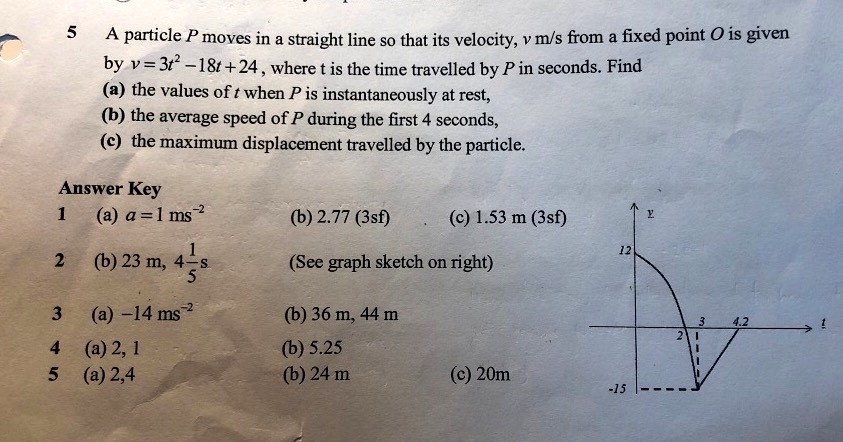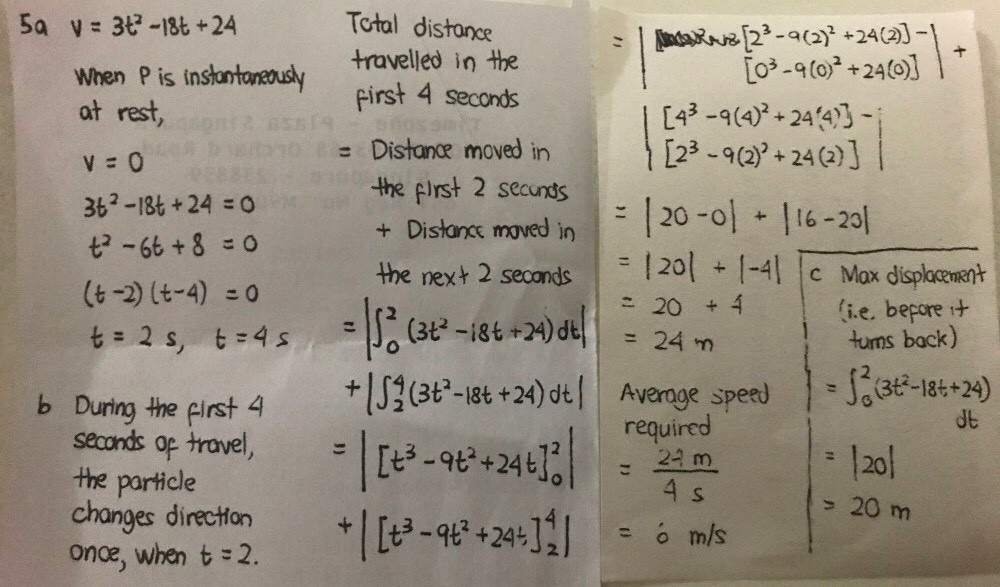Ask Singapore Homework?
Upload a photo of a Singapore homework and someone will email you the solution for free.

Question
secondary 4 | A Maths
One Answer Below
Anyone can contribute an answer, even non-tutors.

i need question 5b & c
the answers are at the bottom :-)
To find average speed we need to find total distance first from 0 to 4 seconds.
The integral of velocity is displacement.
However, we know that v = 0 when t = 2 and t = 4. So between that , the velocity is negative. So if we integrate directly from 0 to 4, the displacement is negative for between t = 2 and t = 4.
So to find the distance travelled , we need to find the absolute value there. So we must integrate separately
so distance travelled
= ∫ (3t² - 18t + 24) (lower bound 0, upper bound 2) + |∫ (3t² - 18t + 24)| ( lower bound 2 , upper bound 4)
= [3t³/3 - 18t²/2 + 24t] + (lower bound 0, upper bound 2) + | [3t³/3 - 18t²/2 + 24t] |( lower bound 2, upper bound 4)
= [2³ - 9(2²) + 24(2)] - [0³ - 9(0²) + 24(0)] +
|4³ - 9(4²) + 24(4)] - [2³ - 9(2²) + 24(2)] |
= 20 + |16 - 20|
= 20 + |-4|
= 20 + 4
= 24
So the distance travelled is 24m.
Then average speed = 24m ÷ 4s = 6m/s
Since the derivative of displacement is velocity, velocity = 0
(It's like displacement is y, velocity is dy/dt,
and we find dy/dt = 0)
We already found from a) that velocity = 0 when t = 2 or 4.
Now we don't know which value is a maximum. So we differentiate the velocity equation to find the acceleration to find out.
(like finding second derivative d²y/dt² , and looking at its sign)
dv/dt = 6t - 18
sub t = 2, dv/dt = 6(2) - 18 = -6 < 0
(maximum)
sub t = 4, dv/dt = 6(4) - 18 = 6 > 0 (minimum)
So we know now that t = 2 gives us the maximum displacement.
Max displacement = 2³ - 9(2²) + 24(2)
= 20m
(already found in part b actually, since the displacement was positive from t = 0 to t = 2, which we directly used to represent the distance travelled for that time duration in b)
Technically that 20 m (when t = 2, before the particle turns back) is a "maximum point" on the graph when plotted on a displacement time graph.
However, the particle does return to its original direction of travel at t = 4. The particle will then never turn direction again and will continue increasing its displacement.
For example, the displacement at t = 6 is actually 36 m, which is greater than the 20 m mentioned.
For the above reasons, the maximum displacement should be at infinity since there is no other given boundary condition for the duration of the travel.
See 1 Answer
The student won't be able to tell without the graph of x³ - 9t² + 24t that the particle turns back at t = 2 and turns again at t = 4
But for 3x² - 18x + 24, a quadratic function , they would be able to tell that velocity is negative between t = 2 and t = 4 since the positive sign of the coefficient of x² suggests it opens upwards (smiling curve)





